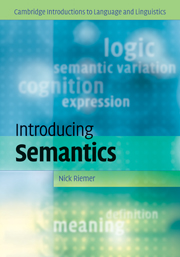Book contents
- Frontmatter
- Contents
- Note to the reader
- 1 Meaning in the empirical study of language
- 2 Meaning and definition
- 3 The scope of meaning I: external context
- 4 The scope of meaning II: interpersonal context
- 5 Analysing and distinguishing meanings
- 6 Logic as a representation of meaning
- 7 Meaning and cognition I: categorization and cognitive semantics
- 8 Meaning and cognition II: formalizing and simulating conceptual representations
- 9 Meaning and morphosyntax I: the semantics of grammatical categories
- 10 Meaning and morphosyntax II: verb meaning and argument structure
- 11 Semantic variation and change
- Glossary
- References
- Index
10 - Meaning and morphosyntax II: verb meaning and argument structure
Published online by Cambridge University Press: 05 June 2012
- Frontmatter
- Contents
- Note to the reader
- 1 Meaning in the empirical study of language
- 2 Meaning and definition
- 3 The scope of meaning I: external context
- 4 The scope of meaning II: interpersonal context
- 5 Analysing and distinguishing meanings
- 6 Logic as a representation of meaning
- 7 Meaning and cognition I: categorization and cognitive semantics
- 8 Meaning and cognition II: formalizing and simulating conceptual representations
- 9 Meaning and morphosyntax I: the semantics of grammatical categories
- 10 Meaning and morphosyntax II: verb meaning and argument structure
- 11 Semantic variation and change
- Glossary
- References
- Index
Summary
CHAPTER PREVIEW
This chapter discusses the semantics of the clause, particularly the relationship between a verb and its noun participants. This relationship is called the verb's argument structure.
There are three basic questions:
What principles determine which of the noun phrases associated with a transitive verb will be expressed as subject and which as object?
Can verbs be grouped into classes about which argument structure generalizations can be made?
Can constructions have meanings on their own?
We begin by looking at the semantics of argument structure, a central topic in investigation of the way semantics and syntax are connected. We introduce and motivate the notion of thematic role, and go on to consider the modifications this notion has undergone in research into argument structure (10.1). We then consider argument structure alternations, (10.2), the name for situations where a single verb can take several different argument structures. Lastly, we consider construction grammar, which attributes many apparently lexical meanings to the grammatical constructions in which they occur (10.3).
Verbs and participants
As the core of the clause, verbs play an important role in the interaction between meaning and syntax. This is because verbs are typically accompanied by nouns which refer to the participants in the event or state the verb describes. These participants receive a range of morphosyntactic markers -case suffixes, subject or object markers, etc. – specifying which participant is the ‘actor’ or instigator of the action, which the undergoer of the action, as well as other possible roles.
- Type
- Chapter
- Information
- Introducing Semantics , pp. 335 - 368Publisher: Cambridge University PressPrint publication year: 2010

